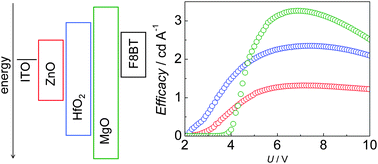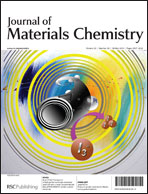Hybrid organic-inorganic light emitting diodes (HyLEDs), employing metal oxides as the electron injecting contacts, are interesting as an alternative to OLEDs. Until recently, the metal oxide of choice was either titanium dioxide or zinc oxide. In this work two wide bandgap metal oxides, HfO2 and MgO, are employed as electron injecting layer in HyLEDs. It is demonstrated that both the current density and the luminance values obtained are directly related to the barriers for electron injection (from the ITO to the metal oxide) and for hole transfer to the same metal oxide, outlining a new design rule for the optimization of HyLEDs. Record device efficacies (3.3 cd/A, >10000 cd/m2) using the commonly used emitting polymer (F8BT) are obtained.
You have access to this article
 Please wait while we load your content...
Something went wrong. Try again?
Please wait while we load your content...
Something went wrong. Try again?


 Please wait while we load your content...
Please wait while we load your content...